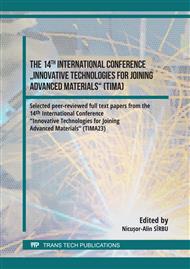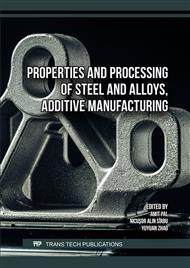[1]
CHOUDHURY, Imtiaz Ahmed; HASHMI, M. S. J. Encyclopedia of renewable and sustainable materials. Elsevier, 2020.
Google Scholar
[2]
VAN HEESWIJK, Ellen PA, et al. Humidity-gated, temperature-responsive photonic infrared reflective broadband coatings. Journal of Materials Chemistry A, 2019, 7.11: 6113-6119.
DOI: 10.1039/c9ta00993k
Google Scholar
[3]
ŁATKA, Leszek, et al. Review of functionally graded thermal sprayed coatings. Applied Sciences, 2020, 10.15: 5153.
DOI: 10.3390/app10155153
Google Scholar
[4]
RICHERSON, David W.; LEE, William E. Modern ceramic engineering: properties, processing, and use in design. CRC press, 2018.
Google Scholar
[5]
CALLISTER JR, William D.; RETHWISCH, David G. Callister's materials science and engineering. John Wiley & Sons, 2020.
Google Scholar
[6]
LINS, Sergio Augusto B.; ROCHA, Marisa Cristina G.; D'ALMEIDA, José Roberto M. Mechanical and thermal properties of high-density polyethylene/alumina/glass fiber hybrid composites. Journal of Thermoplastic Composite Materials, 2019, 32.11: 1566-1581.
DOI: 10.1177/0892705718797391
Google Scholar
[7]
TOMA, Filofteia-Laura, et al. Comparative study of the electrical properties and characteristics of thermally sprayed alumina and spinel coatings. Journal of Thermal Spray Technology, 2011, 20: 195-204.
DOI: 10.1007/s11666-010-9580-2
Google Scholar
[8]
KASPRZYK-HORDERN, Barbara. Chemistry of alumina, reactions in aqueous solution and its application in water treatment. Advances in colloid and interface science, 2004, 110.1-2: 19-48.
DOI: 10.1016/j.cis.2004.02.002
Google Scholar
[9]
Guzanová, A., et al. "Properties of coatings created by HVOF technology using micro-and nano-sized powder." KOM–Corrosion and Material Protection Journal 63.2 (2019): 86-93.
DOI: 10.2478/kom-2019-0011
Google Scholar
[10]
HUTSAYLYUK, Volodymyr, et al. Improvement of wear resistance of aluminum alloy by HVOF method. Journal of Materials Research and Technology, 2020, 9.6: 16367-16377.
DOI: 10.1016/j.jmrt.2020.11.102
Google Scholar
[11]
MEENA, S. L., et al. Effect of load on the wear behaviour of Al2O3 HVOF sprayed coating. In: Journal of Physics: Conference Series. IOP Publishing, 2021. p.012011.
Google Scholar
[12]
Lu, X., Li, G., Kim, J.Y., Mei, D., Lemmon, J.P., Sprenkle, V.L. and Liu, J., 2014. Liquid-metal electrode to enable ultra-low temperature sodium–beta alumina batteries for renewable energy storage. Nature communications, 5(1), p.4578.
DOI: 10.1038/ncomms5578
Google Scholar
[13]
Kaushika, N. D., Mishra, A., & Rai, A. K. (2018). Solar photovoltaics (pp.1-14). Berlin: Springer.
Google Scholar
[14]
Information on: https://alumina.systems/battery-systems/
Google Scholar
[15]
Shahzad, K., Deckers, J., Kruth, J.P. and Vleugels, J., 2013. Additive manufacturing of alumina parts by indirect selective laser sintering and post processing. Journal of Materials Processing Technology, 213(9), pp.1484-1494.
DOI: 10.1016/j.jmatprotec.2013.03.014
Google Scholar



